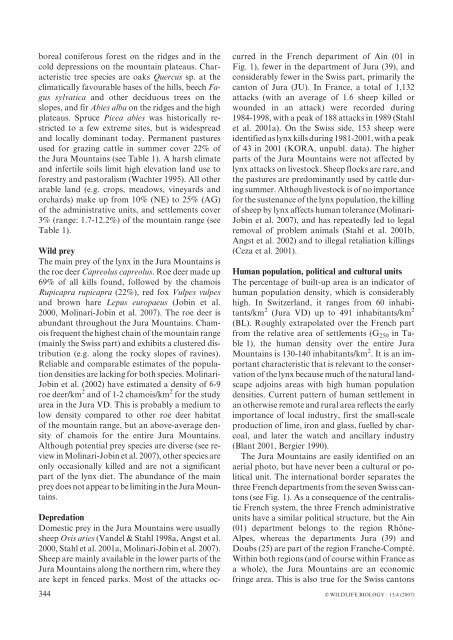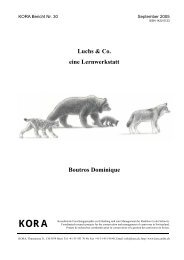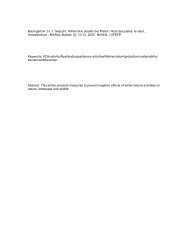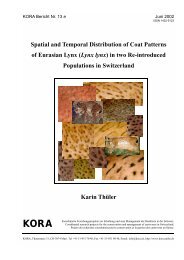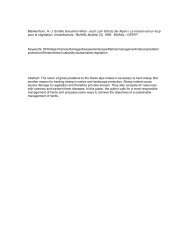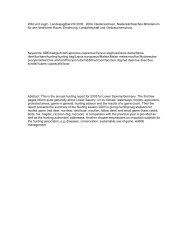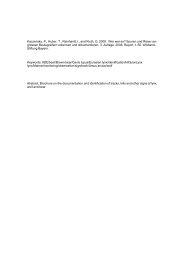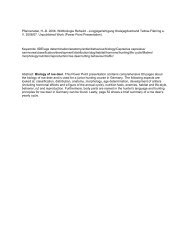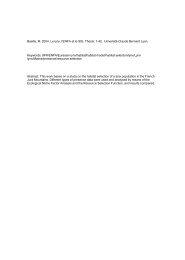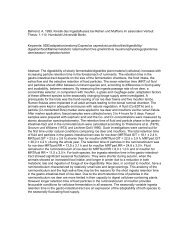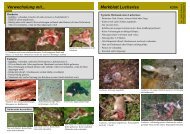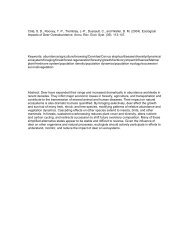Breitenmoser, U., Breitenmoser-Würsten, Ch., Capt, S ... - Kora
Breitenmoser, U., Breitenmoser-Würsten, Ch., Capt, S ... - Kora
Breitenmoser, U., Breitenmoser-Würsten, Ch., Capt, S ... - Kora
Create successful ePaper yourself
Turn your PDF publications into a flip-book with our unique Google optimized e-Paper software.
oreal coniferous forest on the ridges and in the<br />
cold depressions on the mountain plateaus. <strong>Ch</strong>aracteristic<br />
tree species are oaks Quercus sp. at the<br />
climatically favourable bases of the hills, beech Fagus<br />
sylvatica and other deciduous trees on the<br />
slopes, and fir Abies alba on the ridges and the high<br />
plateaus. Spruce Picea abies was historically restricted<br />
to a few extreme sites, but is widespread<br />
and locally dominant today. Permanent pastures<br />
used for grazing cattle in summer cover 22% of<br />
the Jura Mountains (see Table 1). A harsh climate<br />
and infertile soils limit high elevation land use to<br />
forestry and pastoralism (Wachter 1995). All other<br />
arable land (e.g. crops, meadows, vineyards and<br />
orchards) make up from 10% (NE) to 25% (AG)<br />
of the administrative units, and settlements cover<br />
3% (range: 1.7-12.2%) of the mountain range (see<br />
Table 1).<br />
Wild prey<br />
The main prey of the lynx in the Jura Mountains is<br />
the roe deer Capreolus capreolus. Roe deer made up<br />
69% of all kills found, followed by the chamois<br />
Rupicapra rupicapra (22%), red fox Vulpes vulpes<br />
and brown hare Lepus europaeus (Jobin et al.<br />
2000, Molinari-Jobin et al. 2007). The roe deer is<br />
abundant throughout the Jura Mountains. <strong>Ch</strong>amois<br />
frequent the highest chain of the mountain range<br />
(mainly the Swiss part) and exhibits a clustered distribution<br />
(e.g. along the rocky slopes of ravines).<br />
Reliable and comparable estimates of the population<br />
densities are lacking for both species. Molinari-<br />
Jobin et al. (2002) have estimated a density of 6-9<br />
roe deer/km 2 and of 1-2 chamois/km 2 for the study<br />
area in the Jura VD. This is probably a medium to<br />
low density compared to other roe deer habitat<br />
of the mountain range, but an above-average density<br />
of chamois for the entire Jura Mountains.<br />
Although potential prey species are diverse (see review<br />
in Molinari-Jobin et al. 2007), other species are<br />
only occasionally killed and are not a significant<br />
part of the lynx diet. The abundance of the main<br />
prey does not appear to be limiting in the Jura Mountains.<br />
Depredation<br />
Domestic prey in the Jura Mountains were usually<br />
sheep Ovis aries (Vandel & Stahl 1998a, Angst et al.<br />
2000, Stahl et al. 2001a, Molinari-Jobin et al. 2007).<br />
Sheep are mainly available in the lower parts of the<br />
Jura Mountains along the northern rim, where they<br />
are kept in fenced parks. Most of the attacks occurred<br />
in the French department of Ain (01 in<br />
Fig. 1), fewer in the department of Jura (39), and<br />
considerably fewer in the Swiss part, primarily the<br />
canton of Jura (JU). In France, a total of 1,132<br />
attacks (with an average of 1.6 sheep killed or<br />
wounded in an attack) were recorded during<br />
1984-1998, with a peak of 188 attacks in 1989 (Stahl<br />
et al. 2001a). On the Swiss side, 153 sheep were<br />
identified as lynx kills during 1981-2001, with a peak<br />
of 43 in 2001 (KORA, unpubl. data). The higher<br />
parts of the Jura Mountains were not affected by<br />
lynx attacks on livestock. Sheep flocks are rare, and<br />
the pastures are predominantly used by cattle during<br />
summer. Although livestock is of no importance<br />
for the sustenance of the lynx population, the killing<br />
of sheep by lynx affects human tolerance (Molinari-<br />
Jobin et al. 2007), and has repeatedly led to legal<br />
removal of problem animals (Stahl et al. 2001b,<br />
Angst et al. 2002) and to illegal retaliation killings<br />
(Ceza et al. 2001).<br />
Human population, political and cultural units<br />
The percentage of built-up area is an indicator of<br />
human population density, which is considerably<br />
high. In Switzerland, it ranges from 60 inhabitants/km<br />
2 (Jura VD) up to 491 inhabitants/km 2<br />
(BL). Roughly extrapolated over the French part<br />
from the relative area of settlements (G 250 in Table<br />
1), the human density over the entire Jura<br />
Mountains is 130-140 inhabitants/km 2 . It is an important<br />
characteristic that is relevant to the conservation<br />
of the lynx because much of the natural landscape<br />
adjoins areas with high human population<br />
densities. Current pattern of human settlement in<br />
an otherwise remote and rural area reflects the early<br />
importance of local industry, first the small-scale<br />
production of lime, iron and glass, fuelled by charcoal,<br />
and later the watch and ancillary industry<br />
(Blant 2001, Bergier 1990).<br />
The Jura Mountains are easily identified on an<br />
aerial photo, but have never been a cultural or political<br />
unit. The international border separates the<br />
three French departments from the seven Swiss cantons<br />
(see Fig. 1). As a consequence of the centralistic<br />
French system, the three French administrative<br />
units have a similar political structure, but the Ain<br />
(01) department belongs to the region Rhône-<br />
Alpes, whereas the departments Jura (39) and<br />
Doubs (25) are part of the region Franche-Compté.<br />
Within both regions (and of course within France as<br />
a whole), the Jura Mountains are an economic<br />
fringe area. This is also true for the Swiss cantons<br />
344 E WILDLIFE BIOLOGY ? 13:4 (2007)


